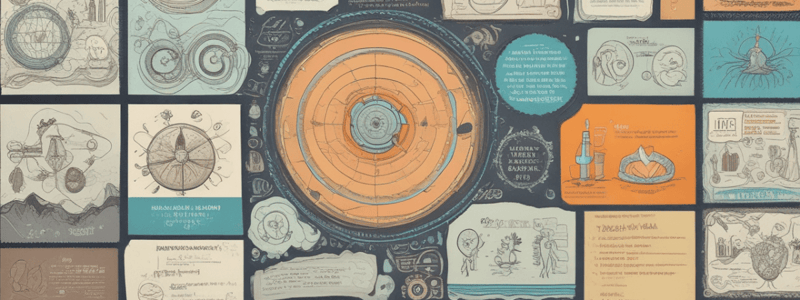Podcast
Questions and Answers
What is the primary goal of a scientific oral presentation?
What is the primary goal of a scientific oral presentation?
- To persuade the audience to adopt a particular point of view
- To educate the audience about a complex scientific topic
- To showcase one's public speaking skills
- To present the results of a scientific investigation in an engaging manner (correct)
Why does Daniel start his presentation with a story?
Why does Daniel start his presentation with a story?
- To make his presentation more interesting and relatable (correct)
- To confuse his audience
- To provide a brief overview of the scientific method
- To establish a personal connection with his audience
How many parts does Daniel separate his talk into?
How many parts does Daniel separate his talk into?
- 6
- 5
- 4 (correct)
- 3
What is the purpose of the Introduction section?
What is the purpose of the Introduction section?
What is the purpose of the Conclusion section?
What is the purpose of the Conclusion section?
Why does Daniel use pictures and videos in his presentation?
Why does Daniel use pictures and videos in his presentation?
What is the key to delivering a scientific oral presentation that is fun and exciting?
What is the key to delivering a scientific oral presentation that is fun and exciting?
What should you do to make your presentation more engaging according to Daniel?
What should you do to make your presentation more engaging according to Daniel?
What should you avoid doing during your presentation?
What should you avoid doing during your presentation?
Why should you keep your presentation simple?
Why should you keep your presentation simple?
What should you focus on when giving your presentation?
What should you focus on when giving your presentation?
Why should you use pictures in your presentation?
Why should you use pictures in your presentation?
What should you avoid providing during your presentation?
What should you avoid providing during your presentation?
How should you structure your presentation?
How should you structure your presentation?
Why is it important to look at your audience during a presentation?
Why is it important to look at your audience during a presentation?
Flashcards are hidden until you start studying
Study Notes
A Scientific Oral Presentation
- A scientific oral presentation is a verbal presentation that presents the results of a scientific investigation, aiming to engage and inform the audience.
Setting Up Your Presentation
- A good presentation starts with a captivating introduction, relating to the problem or topic, making the audience curious and interested.
- Divide the talk into four parts: introduction, method, results, and conclusion.
- Introduction: introduces the problem, encourages curiosity, and sets the tone (about 1 minute).
- Method: explains how the answer was found (about 4 minutes).
- Results: presents the findings (about 4 minutes).
- Conclusion: summarizes the talk, providing a condensed version (about 1 minute).
Key Tips for a Successful Presentation
- Tell a personal story, making the presentation more relatable and engaging.
- Use simple language, avoiding complicated words and confusing statistics.
- Focus on presenting relevant information that supports the conclusion and story.
- Use pictures and visuals to convey the message simply and effectively.
- Be funny and enthusiastic to keep the audience engaged.
What to Avoid
- Avoid looking away from the audience, instead, maintain eye contact with individual listeners.
- Refrain from using filler words (e.g., "like," "um," "so") and avoid giving excessive mathematical details.
- Keep the presentation concise, avoiding unnecessary information.
Studying That Suits You
Use AI to generate personalized quizzes and flashcards to suit your learning preferences.



